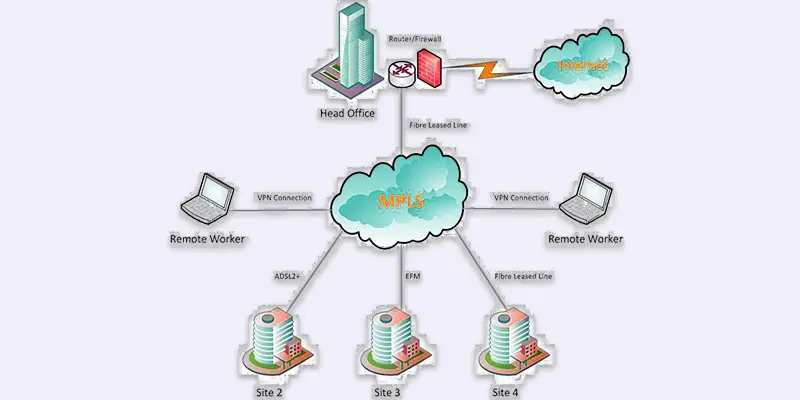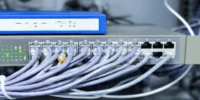What is SD WAN Tunnel, Example, Purpose, Benefits and its Work
Published: 29 May 2025
SD-WAN Tunnel
Did you know that SD-WAN tunnels are revolutionizing how businesses connect remote sites securely and efficiently? Confused about why your traditional VPN setup is slow and hard to manage? You’re not alone. Many businesses struggle with unreliable connections and high costs. Imagine a solution that not only improves performance but also cuts expenses by entering the SD-WAN tunnel, a game-changer for modern networking.
What is SD-WAN Tunnel
An SD-WAN tunnel is a secure, virtual pathway that connects different locations over the internet. It allows businesses to transmit data safely and efficiently between remote sites. Think of it as a private, fast lane for your data within a public network.

Real Life Example of SD-WAN tunnel
A retail chain uses SD-WAN tunnels to connect its stores across different cities, ensuring fast and secure access to the central inventory system. This helps improve performance and reduce downtime, keeping operations running smoothly.
Purpose of SD-WAN tunnel
Here’s the purpose of an SD-WAN tunnel:
- Secure Data Transfer: Ensures safe communication between remote sites.
- Reliable Connectivity: Maintains stable and consistent network performance.
- Optimized Traffic Management: Directs data through the best available path.
- Cost Efficiency: Reduces reliance on expensive MPLS connections.
- Enhanced Scalability: Easily add new locations to the network.
- Performance Monitoring: Continuously tracks connection quality and traffic flow.
How Do SD-WAN Tunnels Work
SD-WAN tunnels work by creating secure, virtual connections between different network locations. They use software to manage traffic, directing data through the most efficient path based on real-time conditions. This ensures fast and reliable communication.
These tunnels also use encryption to keep data safe during transmission. If one connection fails, the system automatically switches to an alternate path to maintain uptime. This makes SD-WAN tunnels a flexible and dependable networking solution.
Key Features of SD-WAN Tunnels
Here are the key features of SD-WAN tunnels in simple terms:
- Secure Connectivity: Protects data with encryption.
- Dynamic Path Selection: Chooses the best route for data in real time.
- Traffic Optimization: Prioritizes important applications for better performance.
- Automated Failover: Switches to a backup path if the main one fails.
- Centralized Management: Controls and monitors multiple tunnels from one place.
- Scalability: Easily adds new locations to the network.
- Cost Efficiency: Reduces expenses by using public networks securely.
SD-WAN Tunnels vs Traditional VPNs
| SD-WAN Tunnels | Traditional VPNs |
|---|---|
| Optimizes traffic for better speed and reliability. | It can be difficult to integrate with cloud apps. |
| Uses advanced encryption and secure pathways. | Basic encryption, often less flexible. |
| Lower operational costs (uses internet instead of MPLS). | Higher costs, especially with MPLS networks. |
| Easily scalable, supports multiple locations. | Harder to scale without expensive upgrades. |
| Automatically selects the best path for data. | Limited routing may result in slower speeds. |
| Prioritizes important traffic like VoIP and video. | No automatic traffic prioritization. |
| Offers centralized management and monitoring. | Requires separate management tools for each location. |
| Automatic failover to backup connections. | Limited failover capabilities. |
| Faster and easier to deploy. | Setup can be complex and time-consuming. |
| Quick adaptation to changing business needs. | Less adaptable to business changes. |
| Seamless integration with cloud services. | Can be difficult to integrate with cloud apps. |
| Reduces latency with dynamic path adjustments. | Higher latency due to static routing. |
| Optimizes performance for specific applications. | No optimization for individual applications. |
| Built-in redundancy for higher reliability. | Redundancy needs manual configuration. |
| Provides real-time performance monitoring and alerts. | Limited or no real-time monitoring capabilities. |
| Consistent and improved user experience. | Can lead to slower or inconsistent experiences. |

| Benefits of Using SD-WAN Tunnels |
|---|
|
Using SD-WAN tunnels offers businesses faster, more secure connections while reducing costs and improving overall network performance.
|
Better Security
SD-WAN tunnels encrypt data to protect it from hackers, ensuring safer connections.
Cost Efficiency
It reduces reliance on expensive private networks, lowering overall costs.
Scalability
Easily add new locations to your network without complicated setups.
Reliable Connectivity
Ensures a stable connection even when one path fails, keeping your network up and running.
Traffic Optimization
Prioritizes important traffic, like video or voice calls, for smoother performance.
Automatic Failover
If one connection goes down, it automatically switches to a backup path, keeping things running.
Centralized Management
Manage and monitor your entire network from a single dashboard for better control.
Simplified Deployment
Set up SD-WAN quickly with minimal effort, reducing setup time.
Cloud Integration
Works seamlessly with cloud applications, making remote work easier.
Reduced Latency
Dynamically routes data to the fastest path, reducing delays.
Importance of SD-WAN Tunnel
The SD-WAN tunnel is crucial for businesses that need secure, reliable connections between remote locations. It ensures that data travels safely across the internet, without compromising performance or security.
This technology is especially important as businesses move more of their operations to the cloud. SD-WAN tunnels make cloud access faster, more reliable, and secure, helping businesses adapt to modern networking needs.

Conclusion About Tunnel of SD WAN
SD-WAN tunnel technology has proven to be an excellent solution for enhancing network performance and reliability. Personally, I recommend considering an SD-WAN tunnel if your business is looking to improve connectivity across multiple locations. It offers cost-effective, secure, and scalable solutions. If you haven’t explored this technology yet, now is the time to start—take the first step toward upgrading your network today.
FAQS
A tunnel is a secure, encrypted pathway in a network, often used to connect different locations or devices.
Tunnel to Towers helps injured first responders, veterans, and their families by providing financial support and building mortgage-free homes.
Tunneling in WAN (Wide Area Network) is a method to send data securely over the internet by creating a tunnel between two points to protect the information.
An SD-WAN tunnel is a secure, encrypted connection between networks, improving performance and reliability by routing traffic over the best available path.
SD-WAN is more advanced and allows better network management and performance optimization, while a VPN tunnel simply secures data between two points without optimizing routes.
VPN secures the connection, but SD-WAN manages traffic smartly and improves performance. SD-WAN can also use VPN tunnels as part of its system.
Businesses with many locations, cloud services, or remote workers need SD-WAN. It helps them stay connected and manage their networks easily.
SD-WAN is cheaper and more flexible than MPLS. It uses the internet and can switch paths quickly if one connection fails.
SD-WAN depends on internet quality, which can be unstable. Also, it may need extra security tools for full protection.
No, SD-WAN and firewalls do different jobs. SD-WAN manages network traffic, while firewalls protect against cyber threats. They work better together.

- Be Respectful
- Stay Relevant
- Stay Positive
- True Feedback
- Encourage Discussion
- Avoid Spamming
- No Fake News
- Don't Copy-Paste
- No Personal Attacks

- Be Respectful
- Stay Relevant
- Stay Positive
- True Feedback
- Encourage Discussion
- Avoid Spamming
- No Fake News
- Don't Copy-Paste
- No Personal Attacks





